2014 PEUGEOT 4008 air condition
[x] Cancel search: air conditionPage 158 of 368

156
Safety
Airbags
System designed to maximise the safety of the
occupants (with the exception of the rear centre
passenger) in the event of violent collisions.
The airbags supplement the action of the force-
limiting seat belts (with the exception of the
centre rear passenger).
If a collision occurs, the electronic detectors
record and analyse the front and side impacts
sustained in the impact detection zones:
- in the case of a serious impact, the airbags
are deployed instantly and contribute
towards better protection of the occupants
of the vehicle (with the exception of the
rear centre passenger); immediately after
the impact, the airbags deflate rapidly so
that they do not hinder visibility or the exit
of the occupants,
- in the case of a minor or rear impact
or in certain roll-over conditions, the
airbags will not be deployed; the seat belt
alone contributes towards ensuring your
protection in these situations.
The airbags do not operate when the
ignition is switched off.
This equipment will only deploy once.
If a second impact occurs (during the
same or a subsequent accident), the
airbag will not be deployed again. Deployment of the airbag(s) is
accompanied by a slight emission
of smoke and a noise, due to the
activation of the pyrotechnic cartridge
incorporated in the system.
This smoke is not harmful, but sensitive
individuals may experience slight
irritation.
The noise of the detonation may result
in a slight loss of hearing for a short
time.
Impact detection zones
A.
Front impact zone.
B.
Side impact zone.
Front airbags
Deployment
The airbags are deployed, except the
passenger's front airbag if it is deactivated,
in the event of a serious front impact applied
to all or part of the front impact zone A
, in
the longitudinal centreline of the vehicle on a
horizontal plane and directed from the front to
the rear of the vehicle.
The front airbag inflates between the front
occupant of the vehicle and the dashboard to
cushion their for ward movement. System which protects the head and chest of
the driver and front passenger in the event of a
front impact.
The driver's airbag is fitted in the centre of the
steering wheel; the front passenger's airbag is
fitted in the dashboard above the glove box.
Page 196 of 368
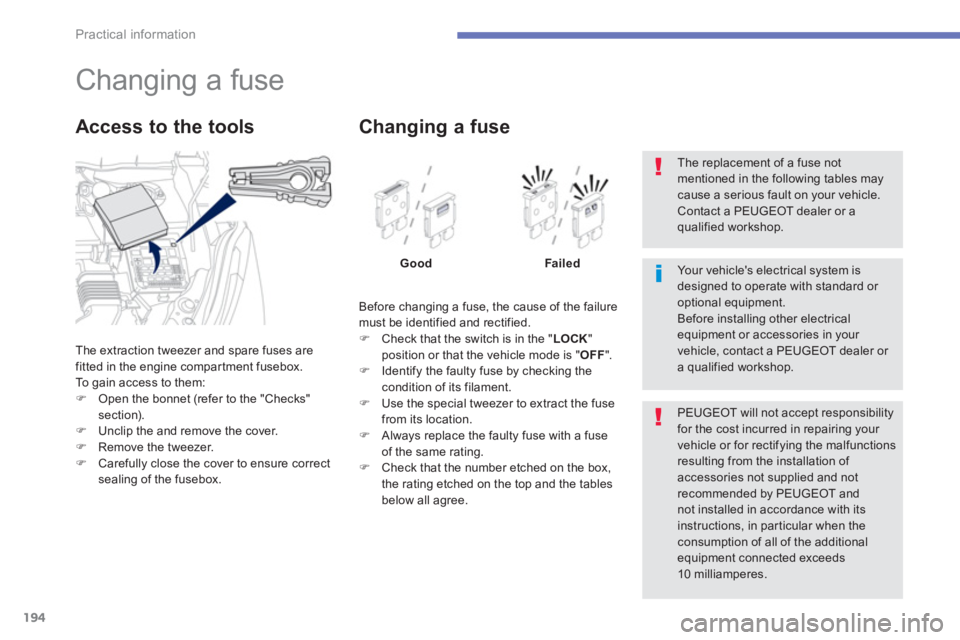
194
Practical information
Changing a fuse
The extraction tweezer and spare fuses are
fitted in the engine compartment fusebox.
To gain access to them:
�)
Open the bonnet (refer to the "Checks"
section).
�)
Unclip the and remove the cover.
�)
Remove the tweezer.
�)
Carefully close the cover to ensure correct
sealing of the fusebox.
Access to the tools
Before changing a fuse, the cause of the failure
must be identified and rectified.
�)
Check that the switch is in the " LOCK
"
position or that the vehicle mode is " OFF
".
�)
Identify the faulty fuse by checking the
condition of its filament.
�)
Use the special tweezer to extract the fuse
from its location.
�)
Always replace the faulty fuse with a fuse
of the same rating.
�)
Check that the number etched on the box,
the rating etched on the top and the tables
below all agree.
Changing a fuse
Good Failed
PEUGEOT will not accept responsibility
for the cost incurred in repairing your
vehicle or for rectifying the malfunctions
resulting from the installation of
accessories not supplied and not
recommended by PEUGEOT and
not installed in accordance with its
instructions, in particular when the
consumption of all of the additional
equipment connected exceeds
10 milliamperes.
Your vehicle's electrical system is
designed to operate with standard or
optional equipment.
Before installing other electrical
equipment or accessories in your
vehicle, contact a PEUGEOT dealer or
a qualified workshop.
The replacement of a fuse not
mentioned in the following tables may
cause a serious fault on your vehicle.
Contact a PEUGEOT dealer or a
qualified workshop.
Page 197 of 368

195
7
Practical information
Dashboard fuses
The fusebox is located in the lower dashboard
(left-hand side).
Access to the fuses
�)
Open the cover and remove it completely
by pulling it towards you.
Fuse N°
Rating
Functions
1
*
30 A
Cabin fan.
2
15 A
Brake lamps, third brake lamp.
3
10 A
Rear foglamps.
4
30 A
Windscreen wiper, screenwash.
6
20 A
Central locking, electric door mirrors.
7
15 A
Audio equipment, telematics, USB unit, Bluetooth system.
8
7.5 A
Remote control key, air conditioning control unit, instrument
panel, electric windows, rain and sunshine sensors, alarm,
switch panel, steering mounted controls.
9
15 A
Instrument panel and interior lighting.
10
15 A
Hazard warning lamps
11
15 A
Rear wiper.
12
7.5 A
Instrument panel, multifunction screen, parking sensors,
heated seats, heated rear screen, electric blind, automatic
headlamp adjustment.
13
15 A
Cigarette lighter, accessory socket.
15
20 A
Electric blind.
16
10 A
Door mirrors, audio equipment.
Page 199 of 368
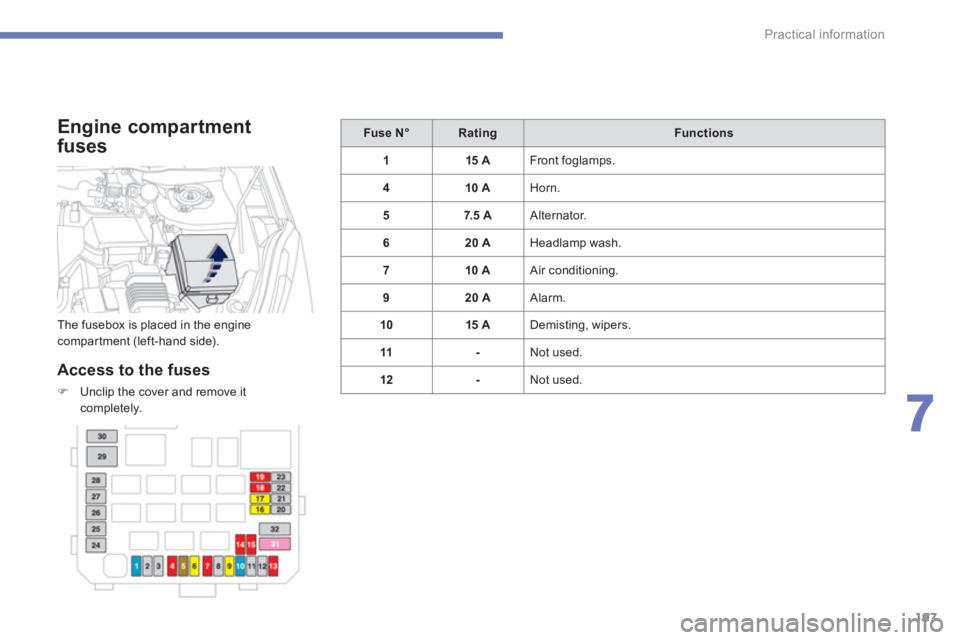
197
7
Practical information
Engine compartment
fuses
Access to the fuses
�)
Unclip the cover and remove it
completely.
Fuse N°
Rating
Functions
1
15 A
Front foglamps.
4
10 A
Horn.
5
7.5 A
Alternator.
6
20 A
Headlamp wash.
7
10 A
Air conditioning.
9
20 A
Alarm.
10
15 A
Demisting, wipers.
11
-
Not used.
12
-
Not used. The fusebox is placed in the engine
compartment (left-hand side).
Page 224 of 368
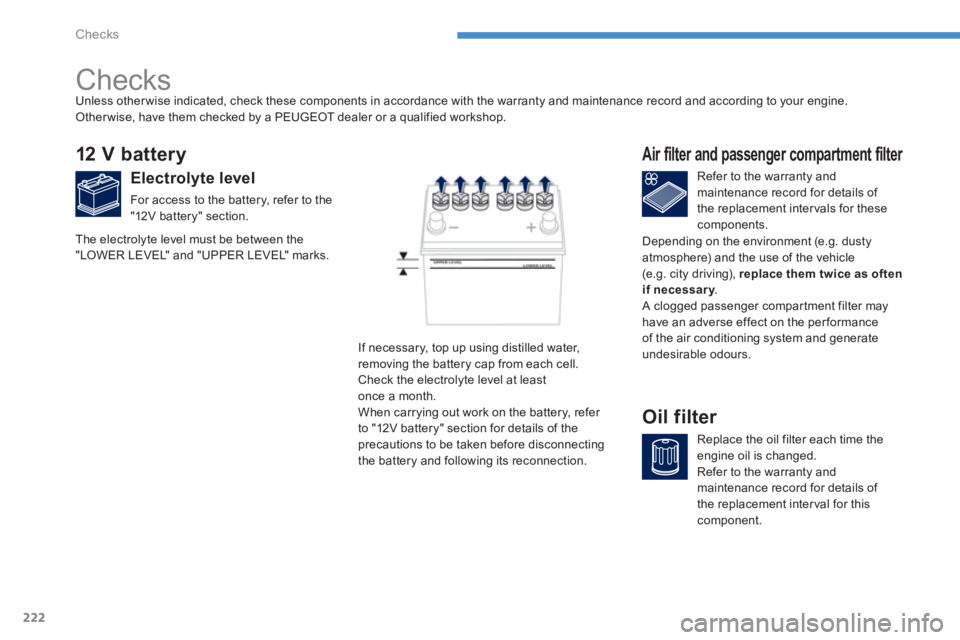
222
Checks
Checks
12 V battery
Electrolyte level
For access to the battery, refer to the
"12V battery" section.
Refer to the warranty and
maintenance record for details of
the replacement inter vals for these
components.
Air filter and passenger compartment filter
Replace the oil filter each time the
engine oil is changed.
Refer to the warranty and
maintenance record for details of
the replacement inter val for this
component.
Oil filter
If necessary, top up using distilled water,
removing the battery cap from each cell.
Check the electrolyte level at least
once a month.
When carrying out work on the battery, refer
to "12V battery" section for details of the
precautions to be taken before disconnecting
the battery and following its reconnection.
Unless other wise indicated, check these components in accordance with the warranty and maintenance record and according to your engine.
Other wise, have them checked by a PEUGEOT dealer or a qualified workshop.
The electrolyte level must be between the
"LOWER LEVEL" and "UPPER LEVEL" marks. Depending on the environment (e.g. dusty
atmosphere) and the use of the vehicle
(e.g. city driving), replace them twice as often
if necessary
.
A clogged passenger compartment filter may
have an adverse effect on the per formance
of the air conditioning system and generate
undesirable odours.
Page 339 of 368
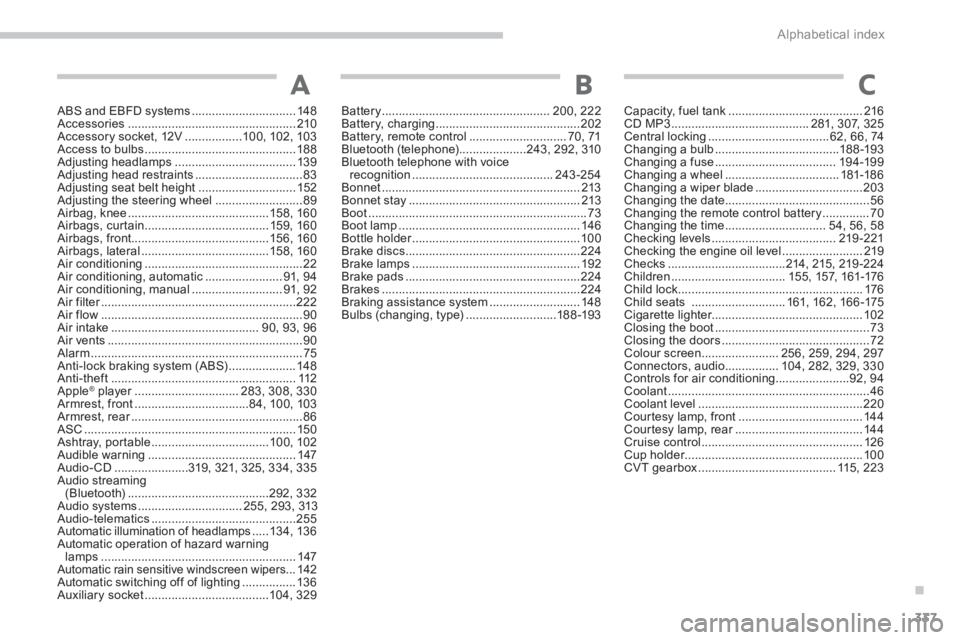
.
337 Alphabetical index
ABS and EBFD systems ............................... 148
Accessories .................................................. 210
Accessory socket, 12V .................100, 102, 103
Access to bulbs ............................................. 188
Adjusting headlamps .................................... 139
Adjusting head restraints ................................83
Adjusting seat belt height ............................. 152
Adjusting the steering wheel ..........................89
Airbag, knee ..........................................158, 160
Airbags, curtain ..................................... 159, 160
Airbags, front.........................................156, 160
Airbags, lateral ......................................158, 160
Air conditioning ...............................................22
Air conditioning, automatic ....................... 91, 94
Air conditioning, manual ........................... 91, 92
Air filter ..........................................................222
Air flow ............................................................90
Air intake ............................................ 90, 93, 96
Air vents ..........................................................90
Alarm ............................................................... 75
Anti-lock braking system (ABS) .................... 148
Anti-theft ....................................................... 112
Apple
® player ............................... 283, 308, 330
Armrest, front ..................................84, 100, 103
Armrest, rear ...................................................86
ASC ............................................................... 150
Ashtray, portable ...................................100, 102
Audible warning ............................................ 147
Audio- CD ......................319, 321, 325, 334, 335
Audio streaming
(Bluetooth) ..........................................292, 332
Audio systems ............................... 255, 293, 313
Audio-telematics ...........................................255
Automatic illumination of headlamps ..... 134, 136
Automatic operation of hazard warning
lamps .......................................................... 147
Automatic rain sensitive windscreen wipers... 142
Automatic switching off of lighting ................ 136
Auxiliary socket .....................................104, 329Battery .................................................. 200, 222
Battery, charging ...........................................202
Battery, remote control ............................. 70, 71
Bluetooth (telephone) ....................243, 292, 310
Bluetooth telephone with voice
recognition .......................................... 243 -254
Bonnet ........................................................... 213
Bonnet stay ................................................... 213
Boot ................................................................. 73
Boot lamp ...................................................... 146
Bottle holder .................................................. 100
Brake discs ....................................................224
Brake lamps .................................................. 192
Brake pads ....................................................224
Brakes ...........................................................224
Braking assistance system ........................... 148
Bulbs (changing, type) ...........................188 -193
AC
Capacity, fuel tank ........................................ 216
CD MP3 ......................................... 281, 307, 325
Central locking .................................... 62, 66, 74
Changing a bulb .....................................188 -193
Changing a fuse .................................... 194-199
Changing a wheel .................................. 181-186
Changing a wiper blade ................................203
Changing the date ...........................................56
Changing the remote control battery .............. 70
Changing the time .............................. 54, 56, 58
Checking levels ..................................... 219 -221
Checking the engine oil level ........................ 219
Checks ...................................214, 215, 219 -224
Children .................................. 155, 157, 161-176
Child lock ....................................................... 176
Child seats ............................ 161, 162, 166 -175
Cigarette lighter............................................. 102
Closing the boot .............................................. 73
Closing the doors ............................................ 72
Colour screen ....................... 256, 259, 294, 297
Connectors, audio ................ 104, 282, 329, 330
Controls for air conditioning ......................92, 94
Coolant ............................................................46
Coolant level .................................................220
Courtesy lamp, front ..................................... 144
Courtesy lamp, rear ...................................... 144
Cruise control ................................................ 126
Cup holder ..................................................... 100
CVT gearbox ......................................... 115, 223
B
Page 346 of 368
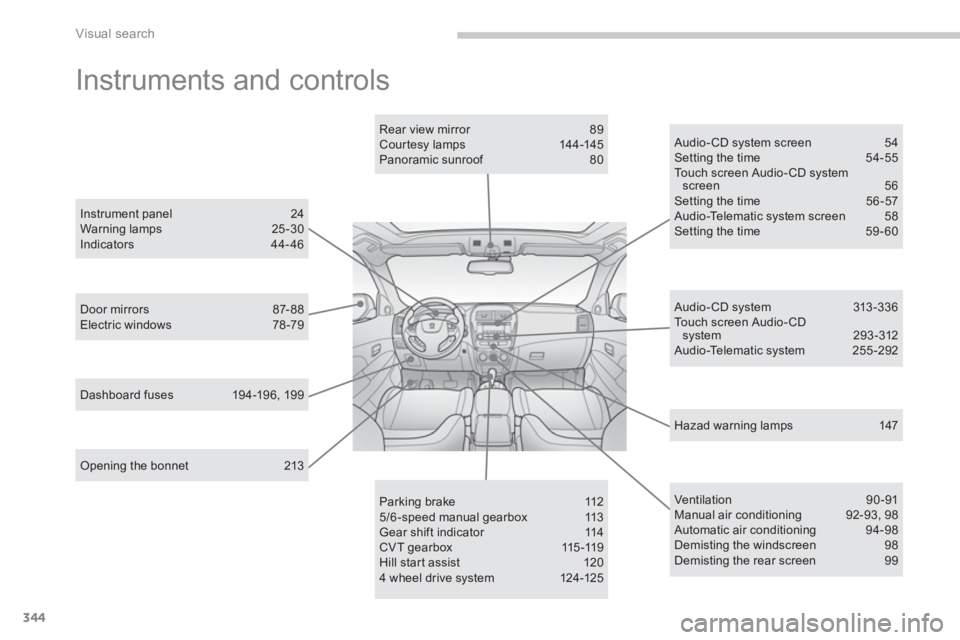
344
Visual search
Instruments and controls
Opening the bonnet 213
Door mirrors 87- 88
Electric windows 78-79
Rear view mirror 89
C our tesy lamps 14 4 -145
Panoramic sunroof 80
Dashboard fuses 194-196, 199
Instrument panel 24
Warning lamps 25 -30
Indicators 44- 46
Audio-CD system screen 54
Setting the time 54-55
Touch screen Audio- CD system
screen 56
Setting the time 56 -57
Audio-Telematic system screen 58
Setting the time 59 - 60
Parking brake 112
5/6 -speed manual gearbox 113
Gear shift indicator 114
CVT gearbox 115 -119
Hill start assist 120
4 wheel drive system 124-125
Audio- CD system 313 -336
Touch screen Audio-CD
system 293 -312
Audio-Telematic system 255 -292
Ventilation 90 -91
Manual air conditioning 92-93, 98
Automatic air conditioning 94-98
Demisting the windscreen 98
Demisting the rear screen 99
Hazad warning lamps 147